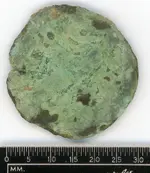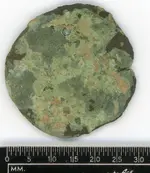Erik in NJ
Silver Member
- Oct 4, 2010
- 4,037
- 3,043
- 🥇 Banner finds
- 1
- Detector(s) used
- Minelab Explorer SE Pro & CTX-3030
- Primary Interest:
- Metal Detecting
I'm not even sure they are Roman, but a friend in England who saw them first hand said they were most likely a Dupondius and a Sesturtius.
OK this was my second or third outing the the field in Devon where I previously unearthed the beautiful Carnelian Domed Silver Thimble. We were on holiday there recently visiting my in-laws and I obtained permission on some local fields adjacent to a 13th century church. On this day I had been starting to grid the field because of the nice things I had been finding. I had found one or two English coins--a Victorian penny ca. 1900 and a King George III half penny which I thought were kind of cool, but I knew that in England they look upon KG coppers sort of the way we do wheat cents, so I wasn't too excited. Then I found these two coins about 20 feet apart and separated by about an hour. I didn't know what they were, but I knew they were old. I didn't want to risk cleaning them in the field. They were both quite heavy and one was rather chunky. Unfortunately the Devon soil has not been very kind to most of the coppers I found especially these two. They have both had a few baths in boiling peroxide and scrubbed with dish soap and a toothbrush. I hesitate to clean them any further. Both have thick green flakey patinas. If anyone has any advice on trying to get some detail to arise please let me know.
The diameter of the smaller coin (what we believe is a Dupondius) is between 25 - 28 mm and it weighs 13.2g. The thickness is approximately 4 mm.
The diameter of the larger coin (what we believe is a Sesturtius) is approximately 30 mm and it weights 12.2g. The thickness is approximately 3 mm.
Now here's the odd thing, there was no real Roman activity in the Devon region as far as I know. So it's quite rare for these coins to have been found there in that field. Additionally, due to the age of the church, I should have found at least a few hammered coins, which I unfortunately did not. These two coins have obviously been in the ground for a long time--probably close to 1,775 years as my friend Chef estimates that they are ca. 250 AD--blowing the doors off of my oldest coin to date which had been ca. 1600!
Anyway, all input is welcome. I'm not sure if it's possible that they are Celtic in origin. I can provide higher res. scans to anyone that might be able to ID them for me. Their compositions are a bit different as they hit at different locations on the Ferrous scale, but are both quite high on the Conductive scale.
Regardless what they are I was over the moon to find these a day after finding that love token, silver thimble, and sweetheart pin (which I have not posted yet).
Thanks for looking!
OK this was my second or third outing the the field in Devon where I previously unearthed the beautiful Carnelian Domed Silver Thimble. We were on holiday there recently visiting my in-laws and I obtained permission on some local fields adjacent to a 13th century church. On this day I had been starting to grid the field because of the nice things I had been finding. I had found one or two English coins--a Victorian penny ca. 1900 and a King George III half penny which I thought were kind of cool, but I knew that in England they look upon KG coppers sort of the way we do wheat cents, so I wasn't too excited. Then I found these two coins about 20 feet apart and separated by about an hour. I didn't know what they were, but I knew they were old. I didn't want to risk cleaning them in the field. They were both quite heavy and one was rather chunky. Unfortunately the Devon soil has not been very kind to most of the coppers I found especially these two. They have both had a few baths in boiling peroxide and scrubbed with dish soap and a toothbrush. I hesitate to clean them any further. Both have thick green flakey patinas. If anyone has any advice on trying to get some detail to arise please let me know.
The diameter of the smaller coin (what we believe is a Dupondius) is between 25 - 28 mm and it weighs 13.2g. The thickness is approximately 4 mm.
The diameter of the larger coin (what we believe is a Sesturtius) is approximately 30 mm and it weights 12.2g. The thickness is approximately 3 mm.
Now here's the odd thing, there was no real Roman activity in the Devon region as far as I know. So it's quite rare for these coins to have been found there in that field. Additionally, due to the age of the church, I should have found at least a few hammered coins, which I unfortunately did not. These two coins have obviously been in the ground for a long time--probably close to 1,775 years as my friend Chef estimates that they are ca. 250 AD--blowing the doors off of my oldest coin to date which had been ca. 1600!
Anyway, all input is welcome. I'm not sure if it's possible that they are Celtic in origin. I can provide higher res. scans to anyone that might be able to ID them for me. Their compositions are a bit different as they hit at different locations on the Ferrous scale, but are both quite high on the Conductive scale.
Regardless what they are I was over the moon to find these a day after finding that love token, silver thimble, and sweetheart pin (which I have not posted yet).
Thanks for looking!
Attachments
Last edited:
Upvote
1












